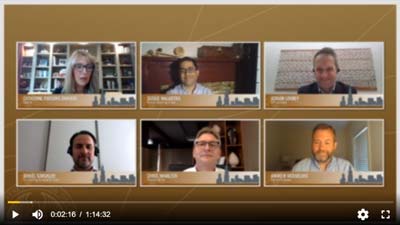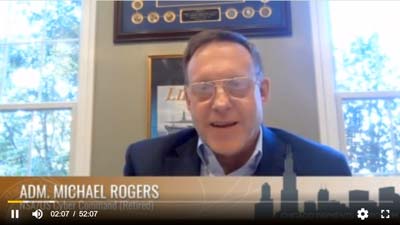Over the past two decades, the Chicago Payments Symposium (Off-site) has been an independent forum where payments industry thought leaders and policymakers gather to learn, debate and share provocative ideas – and ultimately, use those ideas to help shape the future of payments.
This year’s 20th anniversary symposium differed in only one significant way: it was held virtually for the first time due to COVID-19. While most attendees would have preferred an in-person event, the new format won praise and offered some surprising benefits. We recruited more speakers from around the globe and were able to invite a broader mix of payments stakeholders without the worry of limited physical space at the Federal Reserve Bank of Chicago. And, we more than doubled our attendance to nearly 300, with more than a third as first-time attendees.
As one might imagine, the effects of COVID-19 on the payments ecosystem were mentioned by almost every speaker and panelist, including keynote speaker (Off-site) Loretta Mester, president and chief executive officer, Federal Reserve Bank of Cleveland and chair of the Fed’s Financial Services Policy Committee, which oversees its payments activities.
“Although it is safe to say no one anticipated an event quite like the pandemic, the industry’s forethought, investment and preparation to ensure that the payments system would be resilient to extreme scenarios has paid off greatly,” Mester said. “It has allowed us to avoid a collapse of the payments system – an event that would have made what was already a grave situation much, much worse. Another key lesson is that having the right technology in place can make a big difference in being able to address the challenges posed in an environment of rapid change in payments behavior. Industry participants may need to rethink their payments technology investment strategy once we are through the pandemic,” to better support digital, consumer-to-consumer, cross-border and other types of payments, she said.
Additional highlights of the symposium:
 Growing End-to-End Value Around the Core in Networks: Sponsors, service providers, content providers and brands interact in any platform ecosystem and create value by solving problems for their stakeholders. “Providers are learning that the platform is not about the product and it’s not about the device,” said Northwestern University professor Mohan Sawhney. “It’s about addressing the challenges of platform innovation” with a “compelling whole offer.” Customer benefits that are compelling and significantly superior to current solutions should include hardware, software, services, ease of use, ease of access and economic value. He drew parallels to decisions being made today by instant payments platform developers, including the Federal Reserve, that will determine faster payment options for end users.
Growing End-to-End Value Around the Core in Networks: Sponsors, service providers, content providers and brands interact in any platform ecosystem and create value by solving problems for their stakeholders. “Providers are learning that the platform is not about the product and it’s not about the device,” said Northwestern University professor Mohan Sawhney. “It’s about addressing the challenges of platform innovation” with a “compelling whole offer.” Customer benefits that are compelling and significantly superior to current solutions should include hardware, software, services, ease of use, ease of access and economic value. He drew parallels to decisions being made today by instant payments platform developers, including the Federal Reserve, that will determine faster payment options for end users.- Global Developments in Instant Payments: Panelists from Canada, Europe, South Africa and Australia agreed instant payments adoption is on the rise worldwide. Account-to-account faster payments are a growing trend, said panelist Sushil Malhotra of the Boston Consulting Group. “Because these are based on real-time payments, what other types of services can you lump on top of those? We see those as lending and other features on top of on-demand pay and faster pay in the gig economy.”

“There is not just one type of content provider” for instant payments, said Chris Hamilton, CEO of BankServ Africa. “In places like India, there are networks that sit on top of networks. You are starting to see that type of complexity.” That kind of ecosystem is vital. “If you get bogged down in what new service you want to provide, you are going to self-limit the opportunities here. This is a strategic play for the emerging digital economy,” Hamilton said. - FedNowSM Service Update: FedNow Program Executive Ken Montgomery answered questions about FedNow Service features, including plans to use the widely accepted ISO 20022 message standard and other industry best practices to facilitate interoperability. He also reassured listeners that the pandemic has not affected the Fed’s ability to achieve its phased development milestones. “There is much to do, with a complicated deployment and development effort and system integration effort, to get a product to market that is going to have the safety, resiliency, features and functionality we want,” Montgomery said. He added that the platform will combine internally generated code and vendor products, and that the Fed plans ongoing outreach to financial institutions and others that will be involved in the FedNow Service, including a pilot program to be announced soon.
- Activating Instant Payments Adoption in the U.S.: “One of the pleasant surprises about faster payments is that customers love it, and adoption is higher than we had expected,” said Tim Ruhe, Fiserv vice president of payment strategy and partnerships. Recommendations to accelerate U.S. adoption included offering developer-friendly application programming interface (API) layers and educating the industry and customers about pain points that can be addressed with instant payments.
The U.S. Faster Payments Council (FPC) has to “really dig in and create educational materials about how different payments work” and come up with words and phrases that apply to all models and that help people understand what they are signing up for, while also realizing it is not the same as sending a check, said Reed Luhtanen of the FPC.  Security Around the Core: COVID-19 has “exploded” the attack surface as many of us work from home rather than inside a central security stack, said Admiral Mike Rogers, former director of the National Security Agency and former commander of the U.S. Cyber Command. Bad actors look for vulnerabilities within a network’s operation or structure; attempt to trick individuals who have access to networks; and take advantage of remote access partners. One challenge is that speed and efficiency were the primary concerns when the internet was built, rather than security, redundancy or resiliency. Artificial intelligence and machine learning are among the promising tools to combat fraud, but may contain vulnerabilities of their own.
Security Around the Core: COVID-19 has “exploded” the attack surface as many of us work from home rather than inside a central security stack, said Admiral Mike Rogers, former director of the National Security Agency and former commander of the U.S. Cyber Command. Bad actors look for vulnerabilities within a network’s operation or structure; attempt to trick individuals who have access to networks; and take advantage of remote access partners. One challenge is that speed and efficiency were the primary concerns when the internet was built, rather than security, redundancy or resiliency. Artificial intelligence and machine learning are among the promising tools to combat fraud, but may contain vulnerabilities of their own.- Risk Management in a Time of Digital Transformation: Panelists emphasized the importance of balancing the need to detect fraud with artificial intelligence and other tools with the “right amount” of friction that will not discourage customers from making transactions. They also recommended layered authentication and transaction authorization tools that are extensible, global and digitized – and that include recognition of devices, shopping behaviors and payment patterns. The FraudClassifierSM model is a new tool to help capture better, more actionable data. “By leveraging your data more effectively, you are going to be better positioned to protect the front door in terms of authentication strategies,” said Dondi Black, FIS vice president of banking solutions.
- Digital Money: Public digital money facilitates innovation by enabling anyone to participate or deploy code. Permissioned blockchain is private, with access limited to certain participants. Panelists said digital money can make payments more accessible to the un-banked, facilitate cross-border payments and allow payments that aren’t limited to accounts linked to a single financial institution. The next several years will be critical to prove out additional use cases and understand what technical infrastructures will best meet market needs. Brad Garlinghouse, CEO of Ripple, said the focus has to be on present-day problems, and not always on futuristic visions.
Check out the 20th anniversary symposium video (Off-site) to get a sense of the excitement about this event over the years.
